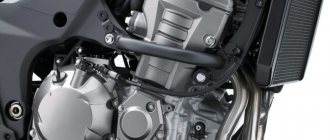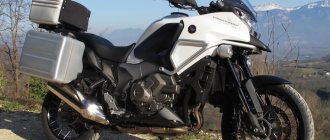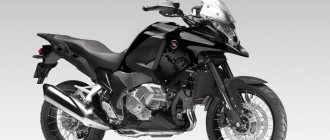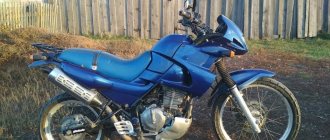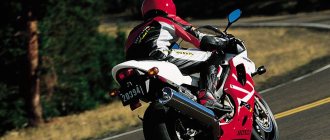Bike features
Here are the main features of the Honda HX 650 Dominator:
- dry sump;
- average weight 152 kg;
- simple pendants.
The model is designed for leisurely tourist trips and will become a reliable assistant on long journeys, both on smooth country roads and off-road (but not too much). The motorcycle is also well suited for the city. The small size of the car makes it easy to maneuver on narrow streets, which is difficult for some giant cruiser.
Disadvantages of the model
- Frequent maintenance required.
- Weak engine for highways and highways.
- The fairly high cost of a motorcycle is typical of Honda motorcycles.
- The standard fairing provides virtually no protection to the driver from headwinds.
The Honda nx 650 dominator is generally a good motorcycle, but still, the 2000s had an engine from the 80s installed; this is justified on budget bikes, but the dominator, unfortunately, is not one of them. The height of the saddle, at first glance, seems high, but in practice it turns out that a man of average height can easily reach the ground. The Honda Dorminator demonstrates excellent performance within the city.
The motorcycle has good acceleration dynamics, which allows you not to experience discomfort in traffic. Outside the city, there is really little power and such driving quickly tires. Reviews about the Honda nx 650 are mostly positive. High quality parts and assembly, Japanese reliability and durability, ease of operation and unpretentiousness made the bike popular, despite its high cost.
Engine
The engine is a four-stroke, single-cylinder type. There are four valves per cylinder. The engine is cooled by air, and its working volume reaches 644 cm³. The NX 250 is equipped with a carburetor fuel supply system.
The maximum characteristics of the unit are as follows: torque at 5000 rpm is 56 Nm, and power at 6000 rpm is 44 hp. This is quite consistent with the motorcycle’s maximum speed of 153 km/h and its acceleration to 100 km/h from zero in 6.5 seconds.
Review of the Honda NX 650 Dominator motorcycle
A very successful car, very popular among connoisseurs of serious long-range driving on any road. The production volumes are small, but the device has maintained its market position for many years without hesitation. Very popular in regions with large uninhabited spaces such as Australia. The vast majority of copies in Russia are those imported second-hand from Japan. However, there are not many of them: the NX650 is a rare bird in the vastness of the Hiroshima region.
Engine
We can only say one thing about the engine – it’s indestructible. Thanks to the careful design of the balancing system, engine vibration is at a very low level for this type of engine. It happens that due to overheating (which is very difficult to achieve), the oil seals burn out and oil consumption increases.
Transmission
The operation of the gearbox is clear and precise. The unit itself is distinguished by enviable reliability, as is the clutch.
Frame and body kit
Despite its somewhat moderate off-road ambitions, the body kit has a very impact-resistant design. And in general, the entire motorcycle is designed with a view to fairly tough operation - it is not so easy to damage it. The gas tank is somewhat small by the standards of off-road travel, but, if desired, this can easily be solved by purchasing a larger capacity tank from third-party manufacturers.
Pendants
The front suspension is somewhat stiff, but the motorcycle does not bite as much when braking. No modifications are required for all-terrain use. It should be noted that the motorcycle is quite sensitive to suspension settings, and changes in driving rhythm and type of surface may require retuning the suspensions. Especially the front one. When off-road, severe wear on the elements of the rear suspension linkage system is noticeable; this requires a thorough check of it when choosing a used motorcycle.
Brakes
In their class they are quite good. In principle, they are quite sufficient for street use.
Comfort
Despite the fact that the motorcycle has strong features of a tough SUV, the overall ergonomics make it an excellent “traveler”, allowing you to spend a lot of time in the saddle, which is what this machine appreciates.
I would say it’s a very interesting device (compared to most 650s, it’s absolutely not a “parutnik” like the BMW 650st), there is a 92G (also Japanese) in the family, it’s quite good on the highway (the stated 160 km/h was never tested (they drove it to 145) and braked - it blows away and the vibration of the engine starts to get louder) and the comfortable speed is 120-130 km/h), he has enough foolishness to drive with a passenger and with loaded panniers on the rear wheel, and not only on asphalt), but I can’t talk about climbing off-road into swamps climbed, coped with forests and fields with a bang, but I’ll tell you that the Honda team performed at the Camel Trophy in 1989
In general, the dilemma now is Honda NX 650 DOMINATOR OR Honda XL 600V TRANSALP????
The Dominator is lighter, better suited for off-road use, and simpler than a single-barreled gun. Very easy to maintain, the only thing simpler than the crossover is probably. The mileage to reserve at a speed of 55-60 miles is 300 km. The most comfortable engine speed for a rider is 3500 rpm.
Although the big ones don’t strain much either - the low degree of forcing has an effect. Driving around the city is a lot of fun, the handling is like a stool. It’s also good for long-distance driving, but if you drive loaded and even more than 100 kg on bad roads, the front suspension is rather weak. An oil change after 3,000 thousand was written in the instructions for the Dominator model of 1987, that is, for the technology of ancient mineral water; according to reviews from foreigners, modern synthetics drive 5-7 thousand km. The brakes are adequate, enough even for a loaded motorcycle.
Taking into account all the strengths and weaknesses of the motorcycle, after long-distance driving in 2005, I will take the XR650L (Dominator engine, frame and suspension of the crossover), for traveling around Kamchatka, as well as long-distance driving in countries with undeveloped road networks. I don’t know about Transalp, but if it is very close to Africa, then the only downside of this motorcycle is that it is less utilitarian than the Dominator and more weight, which only affects weak-bearing soils or when you have fallen. In all other respects there are only advantages; for asphalt it is definitely more preferable.
Dimensions and weight
The weight of the car with fuel reaches 168 kg, and without it - 152 kg. The length of the bike is 2195 mm, the height is 1220 mm, and its width is 890 mm. The wheelbase dimensions of the NX 250 are 1435 mm, and the seat height is 870 mm. All this makes the model not the most suitable for people of short stature and slight build.
The gas tank capacity is 16 liters. Of these, 2.5 liters is a reserve. Considering this volume and dimensions of the motorcycle, fuel consumption is very economical - only 4.7 liters of fuel per 100 km. Depending on the riding style, how loaded the bike is, and how high its speed is, the exact consumption value will change.
HB-Custom
The owner of HB-Custom, Holger Breuer, brought us up to date:
The customer had already contacted me, and I made him a Honda CB900, which he really liked. And then I shared with him the idea of a cool lightweight street tracker as an alternative to his Husqvarna 701 Vitpilen.
“Within 5 minutes he was ready to sell the 701 and start the project.” Holger purchased a 1992 Honda NX650 Dominator, took it to his workshop in Husum and began disassembling it.
Chassis and brakes
The motorcycle is equipped with a stylish looking steel frame. It is immediately clear what type this machine is. The contours characteristic of enduro are difficult to confuse with anything else. The spoked wheels look interesting, so suitable for motorcycles of this class. The steering wheel is medium-sized, comfortable, easy to interact with, including at high speeds.
The bike is equipped with a pendulum suspension at the rear. It has a monoshock absorber. Its stroke is 195 mm. The front suspension is a telescopic fork with dimensions of 41 mm, the travel of which is 220 mm. The rear brakes are provided by a single 220mm disc, assisted by a single-piston caliper. There is also only one disc in this capacity at the front, but its size is 256 mm, and it is supported by a two-piston caliper.
The late '80s and early '90s saw a wave of single- and twin-cylinder trail bikes—Yamaha's single-cylinder XT600 and twin-cylinder XTZ750, Kawasaki's single-cylinder KLR 650 and twin-cylinder KLE500, and Suzuki's DR Big, which eventually became the single-cylinder 800. -th. Even Ducati, Moto Guzzi and Cagiva got in on the action with their own versions of the big twins, which can be summed up as "high seat/high handlebar/big wheels". What they lost in speed compared to the faster 600 4-cylinders, they mostly made up for with outrageous cornering capabilities, plus wheelies and stoppies (maneuvers when driving with the front wheel raised and quick braking ). Just please, remove from this list of motorcycles the Moto Guzzi Quota model, which can neither drive nor stop and has no controllability.
The following can be said about Honda's contribution. The XL600 single cylinder model was for everyone wanting more off-road performance than road style, while the XL600V Transalp harmoniously combined road elegance and the politeness of a V-twin engine with off-road appearance.
The NX650 Dominator is powered by a 4-valve single-cylinder engine that first appeared in the XBR500 single-cylinder retro bike. This engine was "overclocked" to 650cc and installed in an SUV, but certain details, such as the frame-mounted fairing and silver-painted plastic shock plate, revealed its road-going pretensions. It was also very low in cost - the saddle was bolted on, so the glove box was stored down near the front downtube of the frame in a plastic "steal me" box that could be opened with any blunt instrument. The styling was, at least for a time, supersharp - evidenced by the high exhaust levels - almost Ducati-like. The bike actually created a separate urban traillie class and was a great success, despite its traditional high price for Honda.
Then, in the 90s, the 600 racer expanded and put an end to the urban traillie class.
Now in 2001, without sufficient reason, Dommie is still with us in the showrooms. One look at the spec sheet will tell you a lot - 44 hp, 375 lbs, 50 mpg and a fast top speed of over 100 mph. Other than changes to the tubular steel frame structure, the bike has remained virtually unchanged since its original release. It sells for around £5,000 (not a big discount as you can see). The XBR500 produced the same power 15 years ago and was lighter, more fuel efficient and faster.
Driven by the need for success on the track, the Big Four put all their efforts into developing their bikes with engines larger than 600cc. Strangely, nothing worthwhile came out of it - despite the bike's verdict being "excellent", it is a motorcycle that has been left behind by technology. If 100 hp. can be squeezed out of a CBR600 road bike, we can hope for 60 hp. from a 600 cc single-cylinder now.
I went once a year as an instructor. It was good for work and I enjoyed riding it. Excellent high riding position, although the saddle was frankly terrible - sharp edged, a real torture for my other half when she made the mistake of coming for a ride with me in the passenger seat.
Despite the apparent height of the saddle, a man of average height can easily put his feet on the ground. This is a motorcycle with a tight turning circle and easy maneuverability. Handling was impeccable around town, and surprisingly good out of town, with super-quick steering on twisty roads and more ground clearance than I'd dare use. The Avon Gripster tires allowed the bike to corner, had decent grip on wet pavement, and only once in my rides did it feel vague when I put it into a corner at high speed. The front disc felt a little weak under braking, but was quite serviceable.
The standard fairing was rather useless, with a small (2 inches high) screen (just a decorative gizmo that did not protect the pilot from the wind at all). Raising the screen six inches upward resulted in slight buffeting at head level. The headlight was ok (nothing special) but the taillight was quite small and was a nuisance on foggy mornings. I've been thinking about installing something else, but I just can't get around to it.
The controls were typical Honda, and despite the fact that the bike was several years old, they all operated smoothly and without any hiccups. The gear shifter was also a nice standard accessory. Machining is nothing more than OK with lots of big bolts. The pattern on the gas tank and fairing was a little scuffed, although not too much if the bike was tipped over, and some light inspection revealed that there was a small amount of filler in the fairing. The steel heat shield on the exhausts has rusted. The real horror was the exhaust, which had a rusty color, but it did not rust, and after applying black paint everything fell into place. Once the scratches were sanded out, the worst of the rusty bolts were cleaned, painted or replaced, and the wheel rims were tidied up, the bike looked good, if not better. The rear seat pillars were also typical Honda and sagged horribly.
Despite a measly 44 hp, the engine was powerful enough to accelerate quickly in city traffic, but on freeways or long A-roads the ride wasn't much fun. There wasn't enough power for driving beyond 80 miles and handling became a little vague. On most bikes, it's the gas tank limit, the maximum mileage before refueling, that forces you to stop. On the Dominator, the nearly 4-gallon tank gave a range of about 200 miles, but I usually wanted to stop earlier. I rode it back from Yorkshire to London before I installed the taller screen and was glad to stop halfway and rest to relax my neck/butt/ease the blues.
Unlike some of the single cylinders I've ridden (the BMW 650 Funduro and Yamaha SRZ660 are the first ones that come to mind) the Dommie engine was the best. OK, you can't drop the revs all the way down to idle like the four-cylinder, but it slows down to about 2500 rpm with no problems and pulls without chain snags, then revs all the way to a redline of about 7200 rpm without vibration. in the upper range. It's not a lot to redline, but there's enough range to keep three gears available most of the time in a smooth five-speed 'box that gives you the choice of downshifting for extra boost or upshifting for cruising. By comparison, on the Funduro there was usually only one correct gear choice, as the operating range was only just over 3000 rpm, and I either endured engine rumble in the low range or suffered from engine vibration in the top range. The SRZ is even worse - you never feel like you've got the right gear until you change it and find that your new choice is no good at all.
You might be surprised that Dominator was so successful and popular during its early years, where are those old years? The big problem with these engines is the same problem Honda has always had with their SOHC single cylinders. All my CB250RS engines have gone this way between 50 and 80k miles. The XBR has been smoking like a diesel lately and finally broke a valve at 70k. My Dommie ran great until 50k before cam wear and valve train put it beyond economical repair status and it is now in the back of the garage. It's almost impossible to have a suitable used engine or even an entire bike for more than a year or two.
Honda SLR650
As sales of the Dommy began to fall, Honda released a stripped-down, lower-priced version of the Dommy in 1997, priced at £4,500, aimed at a new class of bikers. A new frame and 19-inch front wheel took care of the seat height, a fairly flat horizontal handlebar and round headlight made up the new look, while the tachometer and fairing disappeared altogether in this new version.
Production moved to Spain and the quality of the basic build suffered, with the Brembo brakes (painting them gold didn't make them look any better) and the mirrors being cheap and of poor quality. Surprisingly, the engine did lose power, perhaps due to noise standards that were being tightened at the time, and the SLR's top speed barely made it to 90, politely an asthmatic 39 horsepower. For some reason, Honda also decided to release a 33hp model for restricted license holders. Why they took on two models is unclear to me. Unsurprisingly, sales levels were high, with newer bike buyers, limited by that amount of money or license, looking for the cheaper, higher-performing GS500 or ER5 twins, as well as the similarly priced but arguably top-of-the-line CB500 or even the Bandit and Diversion 600 -s.
Journalists' articles at the time talked about paint washing off on the front of the bike when turning fast. Whether this is due to the fairing or bad tires, I don't know.
Honda FX650 Vigor
In 2000, Honda once again tried to squeeze the juice out of a dead business. We're talking about a lightly restored SLR650 with a stupid name and a price tag of £4,100. Still available in 33hp and 39hp models (with 33hp and 39hp engines).
Conclusion
There's no excuse for a mid-'80s engine in a 2000 model unless it's a budget bike. And the Dommie is not a budget bike. It's not just Honda that's guilty of this - Yamaha is still making its ancient, fundamental bike, the XT600, at an eye-watering £5,000 price tag. The equally venerable, but much cheaper and more capable GS500 or ER5 motorcycle is a significantly better choice as a daily commuter than the cheaper Vigor.
If you're really more into an urban traillie bike then the NX650 will definitely make sense for you, but also worth a look are the cheaper and more modern Suzuki XF650 Freewind at £4500 and the KLR650 at £4400, or the more refined and practical XL650V Transalp for £5400. What I mean is that the KLE500 is still available as a gray import (an imported model that does not have an exact equivalent in the recipient country).
If you're looking for something original, distinctive and with a serious dose of excitement to boot, then check out the enduro or supermotard offerings from CCM, Husaberg and Husqvarna.

